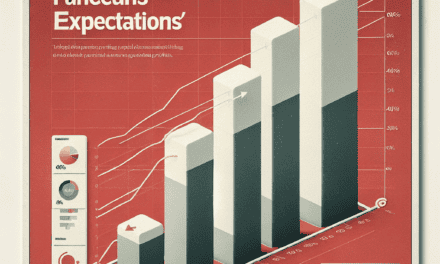“ASML Stock Dips Amidst Market Volatility and Sector Concerns.”
Introduction
ASML Holding NV, a key player in the semiconductor equipment industry, experienced a decline in its stock value today, reflecting a broader trend of volatility in the tech sector. Several factors contributed to this downward movement. Concerns over global economic conditions, including inflationary pressures and potential interest rate hikes, have led investors to reassess their positions in high-growth tech stocks. Additionally, geopolitical tensions and supply chain disruptions continue to pose challenges for the semiconductor industry, impacting companies like ASML. Market analysts also point to recent earnings reports and guidance from ASML that may not have met investor expectations, further influencing the stock’s performance. As a result, ASML’s stock slide today underscores the complex interplay of macroeconomic factors and industry-specific challenges facing the company.
Market Volatility Impacting ASML Stock Prices
ASML Holding, a key player in the semiconductor industry, has recently experienced a notable decline in its stock prices, a trend that has caught the attention of investors and market analysts alike. This downturn can be attributed to a confluence of factors, primarily revolving around the broader market volatility that has been impacting technology stocks globally. As the semiconductor sector is inherently linked to technological advancements and consumer electronics, any fluctuations in these areas tend to have a ripple effect on companies like ASML.
To begin with, the global economic landscape has been fraught with uncertainty, driven by geopolitical tensions, fluctuating interest rates, and concerns over inflation. These macroeconomic factors have collectively contributed to a volatile market environment, prompting investors to reassess their portfolios and adopt a more cautious approach. In such a climate, high-growth technology stocks, including ASML, often bear the brunt of market sell-offs as investors seek safer, more stable investment avenues.
Moreover, the semiconductor industry itself is facing its own set of challenges. Supply chain disruptions, which have been a persistent issue since the onset of the COVID-19 pandemic, continue to affect production timelines and cost structures. ASML, being a supplier of advanced lithography equipment essential for semiconductor manufacturing, is not immune to these disruptions. Any delays or increased costs in the supply chain can directly impact the company’s financial performance, thereby influencing investor sentiment and stock prices.
In addition to supply chain issues, the semiconductor industry is also grappling with fluctuating demand dynamics. While there has been a surge in demand for semiconductors driven by the proliferation of digital technologies and the growing adoption of electric vehicles, there are concerns about potential overcapacity in the market. If supply outpaces demand, it could lead to a decrease in chip prices, which would adversely affect the revenue streams of companies like ASML.
Furthermore, regulatory developments in key markets have also played a role in the recent slide of ASML’s stock. For instance, increased scrutiny and potential restrictions on technology exports to certain regions could limit ASML’s market access and growth prospects. Such regulatory uncertainties add another layer of complexity to the investment landscape, making investors wary of potential risks.
Despite these challenges, it is important to note that ASML remains a fundamentally strong company with a robust technological edge. The company’s leadership in extreme ultraviolet (EUV) lithography technology positions it well to capitalize on the ongoing advancements in semiconductor manufacturing. However, in the current market environment, even companies with strong fundamentals are not immune to the effects of broader market trends.
In conclusion, the recent decline in ASML’s stock prices can be largely attributed to the prevailing market volatility and the specific challenges facing the semiconductor industry. While these factors have created a challenging environment for ASML and its investors, the company’s long-term prospects remain promising. As the market continues to navigate through these turbulent times, it will be crucial for investors to maintain a balanced perspective, recognizing both the immediate challenges and the underlying strengths of companies like ASML.
Recent Earnings Report Disappoints Investors
ASML Holding, a key player in the semiconductor industry, has recently experienced a notable decline in its stock value, leaving investors concerned about the company’s future prospects. This downturn can be largely attributed to the company’s recent earnings report, which failed to meet the high expectations set by market analysts and investors alike. As a result, the stock has been sliding, prompting a closer examination of the factors contributing to this disappointing performance.
To begin with, ASML’s earnings report revealed a mixed bag of results that did not align with the optimistic forecasts that had been circulating prior to its release. While the company did report an increase in revenue compared to the previous quarter, the growth rate was not as robust as anticipated. This slower-than-expected growth has raised questions about the company’s ability to maintain its competitive edge in an industry characterized by rapid technological advancements and intense competition.
Moreover, the earnings report highlighted some operational challenges that ASML is currently facing. Supply chain disruptions, which have been a persistent issue across various industries, have also impacted ASML’s production capabilities. These disruptions have led to delays in the delivery of critical components, thereby affecting the company’s ability to meet customer demand in a timely manner. Consequently, this has resulted in a backlog of orders, further exacerbating investor concerns about the company’s short-term performance.
In addition to supply chain issues, ASML is also grappling with rising production costs. The semiconductor industry is heavily reliant on advanced technology and specialized equipment, both of which have seen significant price increases in recent months. These rising costs have put pressure on ASML’s profit margins, making it more challenging for the company to achieve the level of profitability that investors have come to expect. As a result, the company’s financial outlook appears less favorable, contributing to the downward pressure on its stock price.
Furthermore, the broader economic environment has also played a role in ASML’s recent stock slide. With concerns about inflation and potential interest rate hikes looming, investors have become increasingly cautious about their investments in technology stocks, which are often seen as more volatile in uncertain economic times. This shift in investor sentiment has led to a reevaluation of ASML’s stock, with some opting to reduce their exposure to the company in favor of more stable investment opportunities.
Despite these challenges, it is important to note that ASML remains a dominant force in the semiconductor industry, with a strong track record of innovation and a solid customer base. The company’s leadership in the development of advanced lithography machines, which are essential for the production of cutting-edge microchips, continues to be a significant competitive advantage. However, in order to regain investor confidence and reverse the recent stock slide, ASML will need to address the operational and financial challenges it currently faces.
In conclusion, the recent decline in ASML’s stock value can be attributed to a combination of disappointing earnings results, operational challenges, and broader economic concerns. While the company remains a key player in the semiconductor industry, it must navigate these hurdles effectively to reassure investors and restore its stock’s upward trajectory. As the industry continues to evolve, ASML’s ability to adapt and innovate will be crucial in determining its long-term success and stability in the market.
Global Semiconductor Shortage Concerns
ASML Holding, a key player in the semiconductor industry, has recently experienced a decline in its stock value, a trend that has raised eyebrows among investors and analysts alike. This downturn can be attributed to the ongoing global semiconductor shortage, a crisis that has sent ripples across various sectors reliant on these critical components. To understand why ASML’s stock is sliding, it is essential to delve into the broader context of the semiconductor shortage and its implications for the industry.
The semiconductor shortage, which began in earnest during the COVID-19 pandemic, has been exacerbated by a confluence of factors. Initially, the pandemic disrupted supply chains worldwide, leading to production halts and logistical challenges. As economies began to recover, demand for electronic devices surged, driven by remote work, online education, and increased consumer spending on technology. This sudden spike in demand outpaced the supply capabilities of semiconductor manufacturers, creating a bottleneck that persists to this day.
ASML, a Dutch company renowned for its advanced lithography machines used in semiconductor manufacturing, is not immune to these industry-wide challenges. While the company plays a crucial role in the production of cutting-edge chips, it is also dependent on a complex network of suppliers and customers. The shortage has led to delays in the delivery of essential components, impacting ASML’s ability to meet its production targets and, consequently, affecting its financial performance.
Moreover, the semiconductor shortage has prompted governments and companies to reassess their supply chain strategies. Many are now investing in domestic semiconductor manufacturing capabilities to reduce reliance on foreign suppliers. While this shift presents long-term opportunities for ASML, it also introduces short-term uncertainties. The transition to localized production may lead to fluctuations in demand for ASML’s equipment, as companies adjust their strategies and timelines.
In addition to supply chain disruptions, geopolitical tensions have further complicated the semiconductor landscape. Trade disputes and export restrictions, particularly between the United States and China, have created an environment of uncertainty. ASML, which operates globally, must navigate these geopolitical challenges carefully. Any escalation in trade tensions could impact its ability to conduct business in key markets, thereby affecting its revenue streams.
Furthermore, the semiconductor industry is characterized by rapid technological advancements and intense competition. Companies are under constant pressure to innovate and deliver more powerful and efficient chips. ASML’s success hinges on its ability to stay at the forefront of technological developments. However, the current shortage has diverted resources and attention away from research and development, potentially hindering ASML’s competitive edge in the long run.
Despite these challenges, it is important to note that ASML remains a dominant force in the semiconductor industry. The company’s expertise in extreme ultraviolet (EUV) lithography technology positions it as a critical enabler of next-generation chip production. As the industry gradually overcomes the current shortage, ASML is likely to benefit from the increased demand for advanced manufacturing equipment.
In conclusion, the sliding of ASML’s stock can be attributed to the multifaceted challenges posed by the global semiconductor shortage. While the company faces short-term hurdles related to supply chain disruptions, geopolitical tensions, and competitive pressures, its long-term prospects remain promising. As the industry adapts to the evolving landscape, ASML’s strategic positioning and technological prowess are expected to drive its recovery and growth in the years to come.
Competitive Pressures in the Semiconductor Industry
ASML Holding, a key player in the semiconductor industry, has recently experienced a decline in its stock value, a trend that has caught the attention of investors and analysts alike. This downturn can be attributed to a confluence of factors, primarily revolving around the intensifying competitive pressures within the semiconductor sector. As the industry evolves, companies are grappling with the need to innovate rapidly while managing the challenges posed by emerging competitors and shifting market dynamics.
To begin with, the semiconductor industry is characterized by its rapid pace of technological advancement and high capital requirements. ASML, known for its cutting-edge lithography machines, has long been a leader in this space. However, the landscape is changing as new entrants and existing competitors strive to capture market share. Companies such as Taiwan Semiconductor Manufacturing Company (TSMC) and Samsung are investing heavily in research and development to enhance their manufacturing capabilities. This increased competition is putting pressure on ASML to maintain its technological edge and justify its premium pricing.
Moreover, the global semiconductor market is experiencing a shift in demand patterns. The rise of artificial intelligence, the Internet of Things, and 5G technology has led to a surge in demand for advanced chips. While this presents an opportunity for growth, it also means that companies must continuously innovate to meet the evolving needs of their customers. ASML’s ability to adapt to these changes is crucial for its long-term success. However, the company’s reliance on a few key customers, such as Intel and TSMC, makes it vulnerable to fluctuations in their purchasing decisions.
In addition to these competitive pressures, geopolitical tensions are also playing a significant role in shaping the semiconductor industry. Trade disputes and export restrictions, particularly between the United States and China, have created an uncertain environment for companies operating in this sector. ASML, which supplies its machines globally, must navigate these complexities to ensure a steady flow of business. The company’s recent stock slide can be partially attributed to investor concerns about how these geopolitical factors might impact its operations and profitability.
Furthermore, the semiconductor industry is facing supply chain challenges that have been exacerbated by the COVID-19 pandemic. Disruptions in the supply of raw materials and components have led to production delays and increased costs. ASML, like many other companies, is working to mitigate these issues, but the uncertainty surrounding supply chain stability continues to weigh on investor sentiment.
Despite these challenges, it is important to note that ASML remains a formidable player in the semiconductor industry. The company’s commitment to innovation and its strong market position provide a solid foundation for future growth. However, the current competitive pressures and external factors necessitate a strategic approach to ensure sustained success. Investors will be closely monitoring ASML’s ability to navigate these challenges and capitalize on emerging opportunities.
In conclusion, the recent decline in ASML’s stock value can be attributed to a combination of competitive pressures, shifting market dynamics, geopolitical tensions, and supply chain challenges. While these factors present significant hurdles, they also underscore the importance of strategic agility and innovation in the semiconductor industry. As ASML continues to adapt to this evolving landscape, its ability to maintain its leadership position will be crucial in determining its future trajectory.
Regulatory Challenges Facing ASML
ASML Holding, a key player in the semiconductor industry, has recently faced a series of regulatory challenges that have contributed to the decline in its stock value. These challenges are not only affecting ASML but are also indicative of broader geopolitical tensions and regulatory shifts impacting the global technology sector. Understanding the intricacies of these regulatory hurdles is essential for investors and industry observers alike, as they navigate the complexities of the current market environment.
To begin with, ASML’s position as a leading supplier of photolithography machines, which are crucial for semiconductor manufacturing, places it at the center of international trade dynamics. The company’s advanced extreme ultraviolet (EUV) lithography machines are indispensable for producing cutting-edge chips, making ASML a critical supplier to major technology firms worldwide. However, this strategic importance has also made ASML a focal point in the ongoing trade tensions between major economies, particularly the United States and China.
In recent months, the U.S. government has intensified its efforts to restrict China’s access to advanced semiconductor technologies, citing national security concerns. These restrictions have included lobbying efforts to persuade allied nations to limit the export of critical technologies to China. As a result, ASML has found itself under pressure to comply with these export controls, which could potentially limit its ability to sell its most advanced equipment to Chinese customers. This situation has raised concerns among investors about ASML’s future revenue streams and market expansion opportunities in one of the world’s largest semiconductor markets.
Moreover, the European Union, where ASML is headquartered, has also been grappling with its own regulatory challenges. The EU is striving to balance its economic interests with geopolitical considerations, particularly in light of its strategic autonomy agenda. This has led to increased scrutiny of technology exports and a reevaluation of trade relationships with key partners. For ASML, navigating these regulatory landscapes requires careful diplomacy and strategic decision-making to ensure compliance while safeguarding its business interests.
In addition to geopolitical factors, ASML is also facing regulatory challenges related to intellectual property and technology transfer. As the company continues to innovate and develop cutting-edge technologies, protecting its intellectual property becomes increasingly vital. However, the global nature of the semiconductor supply chain means that ASML must collaborate with various international partners, which can complicate efforts to safeguard proprietary technologies. Ensuring robust intellectual property protection while fostering collaboration is a delicate balance that ASML must maintain to sustain its competitive edge.
Furthermore, environmental regulations are becoming an increasingly important consideration for technology companies, including ASML. As governments worldwide implement stricter environmental standards, ASML must adapt its manufacturing processes and supply chain practices to meet these requirements. This involves investing in sustainable technologies and practices, which can entail significant costs and operational adjustments. While these efforts are crucial for long-term sustainability, they also present short-term challenges that can impact financial performance and investor sentiment.
In conclusion, the regulatory challenges facing ASML are multifaceted and stem from a combination of geopolitical tensions, intellectual property concerns, and environmental considerations. These factors have contributed to the recent slide in ASML’s stock value, as investors weigh the potential impacts on the company’s growth prospects and market position. As ASML navigates this complex landscape, its ability to adapt and respond to these challenges will be critical in determining its future trajectory in the global semiconductor industry.
Analyst Downgrades and Their Effects on ASML
ASML Holding, a prominent player in the semiconductor industry, has recently experienced a decline in its stock value, a trend that has caught the attention of investors and analysts alike. This downturn can be attributed to a series of analyst downgrades, which have significantly impacted market perceptions and investor confidence. Understanding the reasons behind these downgrades and their subsequent effects on ASML’s stock is crucial for stakeholders looking to navigate the current market landscape.
To begin with, analyst downgrades often serve as a barometer for investor sentiment, reflecting concerns about a company’s future performance. In the case of ASML, these downgrades have been primarily driven by apprehensions regarding the broader semiconductor market. The industry has been grappling with a cyclical downturn, characterized by fluctuating demand and supply chain disruptions. Analysts have expressed concerns that these challenges could hinder ASML’s growth prospects in the near term, prompting them to reassess their ratings and price targets for the company.
Moreover, the global economic environment has added another layer of complexity to ASML’s situation. With rising inflation and geopolitical tensions, there is increased uncertainty surrounding consumer spending and industrial investments. These macroeconomic factors have led analysts to adopt a more cautious stance, further contributing to the downgrades. As a result, investors have become wary, leading to a sell-off in ASML’s stock as they seek to mitigate potential risks.
In addition to these external factors, internal dynamics within ASML have also played a role in shaping analyst opinions. While ASML remains a leader in the production of advanced lithography machines, which are essential for manufacturing cutting-edge semiconductors, the company faces intense competition from other industry giants. Analysts have raised concerns about ASML’s ability to maintain its competitive edge, particularly in light of technological advancements by rivals. This competitive pressure has fueled doubts about ASML’s long-term market position, contributing to the downgrades.
Furthermore, the impact of these downgrades on ASML’s stock cannot be understated. When analysts lower their ratings or price targets, it often triggers a ripple effect across the market. Institutional investors, who rely heavily on analyst reports to guide their investment decisions, may adjust their portfolios accordingly. This can lead to increased selling pressure on the stock, exacerbating the decline in its value. Additionally, retail investors, who closely monitor analyst opinions, may also be influenced by these downgrades, further amplifying the downward trend.
Despite the current challenges, it is important to note that ASML’s long-term prospects remain promising. The company continues to invest in research and development, aiming to push the boundaries of semiconductor technology. As the demand for advanced chips continues to grow, driven by emerging technologies such as artificial intelligence and 5G, ASML is well-positioned to capitalize on these opportunities. However, in the short term, the effects of analyst downgrades are likely to persist, as market participants remain cautious amid ongoing uncertainties.
In conclusion, the recent slide in ASML’s stock can be attributed to a confluence of factors, including analyst downgrades driven by concerns about the semiconductor market, macroeconomic challenges, and competitive pressures. While these downgrades have undoubtedly impacted investor sentiment and stock performance, ASML’s long-term potential remains intact. As the company navigates these turbulent times, stakeholders will be closely monitoring developments to assess the trajectory of ASML’s stock in the coming months.
Geopolitical Tensions Affecting ASML’s Market Position
ASML Holding, a pivotal player in the semiconductor industry, has recently experienced a notable decline in its stock value, a trend that can be attributed to escalating geopolitical tensions. As the world’s leading supplier of photolithography machines, which are essential for the production of advanced microchips, ASML’s market position is inherently sensitive to international relations and trade policies. The company’s stock has been sliding, reflecting investor concerns over the potential impact of these geopolitical dynamics on its business operations and future growth prospects.
To understand the current situation, it is essential to consider the broader context of global trade relations, particularly between the United States and China. The semiconductor industry has become a focal point in the ongoing trade disputes between these two economic powerhouses. The U.S. government has been increasingly assertive in its efforts to restrict China’s access to advanced semiconductor technology, citing national security concerns. This has led to a series of export controls and sanctions aimed at curbing China’s technological advancements. Consequently, companies like ASML, which supply critical equipment to semiconductor manufacturers worldwide, find themselves caught in the crossfire.
ASML’s advanced extreme ultraviolet (EUV) lithography machines are indispensable for producing the most cutting-edge chips, and China represents a significant market for these machines. However, the Dutch government, under pressure from the United States, has imposed restrictions on ASML’s ability to sell its most advanced equipment to Chinese customers. This has raised concerns about the company’s ability to maintain its growth trajectory, as China has been a major driver of demand for semiconductor manufacturing equipment.
Moreover, the geopolitical landscape is further complicated by the European Union’s position in this global tug-of-war. As a Dutch company, ASML is subject to EU regulations and policies, which are often influenced by the bloc’s broader strategic interests. The EU has been striving to balance its economic ties with China while aligning with the United States on security issues. This delicate balancing act adds another layer of uncertainty to ASML’s market position, as any shifts in EU policy could have significant implications for the company’s operations.
In addition to these geopolitical factors, the semiconductor industry is also grappling with supply chain disruptions and a global chip shortage, which have been exacerbated by the COVID-19 pandemic. These challenges have put additional pressure on ASML, as manufacturers worldwide scramble to secure the necessary equipment to ramp up production and meet soaring demand. The combination of supply chain constraints and geopolitical tensions creates a complex environment for ASML, making it difficult for investors to predict the company’s future performance with confidence.
In conclusion, ASML’s recent stock slide can be attributed to a confluence of geopolitical tensions, trade restrictions, and industry-specific challenges. As the semiconductor industry continues to navigate these turbulent waters, ASML’s ability to adapt to changing market conditions and geopolitical realities will be crucial in determining its long-term success. Investors will be closely monitoring developments in international trade policies and supply chain dynamics, as these factors will play a pivotal role in shaping ASML’s market position and financial performance in the coming years.
Q&A
1. **Question:** What was the primary reason for ASML stock sliding today?
– **Answer:** ASML stock was sliding due to concerns over potential restrictions on semiconductor equipment sales to China.
2. **Question:** How did geopolitical tensions impact ASML’s stock performance?
– **Answer:** Geopolitical tensions, particularly between the U.S. and China, raised fears of reduced market access for ASML, impacting its stock negatively.
3. **Question:** Did any recent government actions contribute to the decline in ASML’s stock?
– **Answer:** Yes, recent government actions or proposed regulations limiting technology exports to China contributed to the decline.
4. **Question:** Was there any specific news about ASML’s financial performance that affected its stock?
– **Answer:** No specific financial performance news was reported; the decline was more related to external geopolitical factors.
5. **Question:** How did the broader semiconductor industry trend affect ASML’s stock?
– **Answer:** The broader semiconductor industry faced pressure due to potential trade restrictions, which also negatively affected ASML’s stock.
6. **Question:** Were there any analyst downgrades or changes in stock ratings for ASML?
– **Answer:** There were no specific analyst downgrades reported; the stock movement was primarily due to geopolitical concerns.
7. **Question:** Did ASML issue any statements regarding the stock slide?
– **Answer:** ASML did not issue any specific statements addressing the stock slide at the time.
Conclusion
ASML stock was sliding again today due to a combination of factors, including concerns over the semiconductor industry’s cyclical downturn, potential geopolitical tensions affecting supply chains, and investor apprehension about future demand for semiconductor equipment. Additionally, broader market volatility and economic uncertainties may have contributed to the decline, as investors reassess growth prospects and risk exposure in the technology sector.





